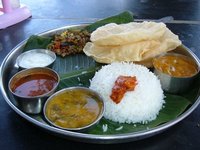 Take the foreigner's first trip to the bathroom in India - always an awkward and baffling learning experience. As often as not, one finds a simple hole in the floor, but in more posh facilities they may be treated to a raised platform with two footpads, a faucet, a small pale, and a vessel the size and shape of a measuring cup. Without being too graphic, it is enough to say that the sequence that properly follows is far from intuitive, and it is really necessary to be instructed on how to carry out even this most basic bodily function in India. For those accustomed to toilet paper (something that most Indians find unsanitary) the options are limited in India by the fact that almost nowhere is there the plumbing to handle this kind of waist. Even though the toilet in this picture has a basin allowing it to flush, it still has the equipment to be used Indian style.
Take the foreigner's first trip to the bathroom in India - always an awkward and baffling learning experience. As often as not, one finds a simple hole in the floor, but in more posh facilities they may be treated to a raised platform with two footpads, a faucet, a small pale, and a vessel the size and shape of a measuring cup. Without being too graphic, it is enough to say that the sequence that properly follows is far from intuitive, and it is really necessary to be instructed on how to carry out even this most basic bodily function in India. For those accustomed to toilet paper (something that most Indians find unsanitary) the options are limited in India by the fact that almost nowhere is there the plumbing to handle this kind of waist. Even though the toilet in this picture has a basin allowing it to flush, it still has the equipment to be used Indian style.Then of course there are the accompanying cultural norms which have come as a consequence of Indian toilet habits, including the strict division between what one does with their left and their right hand, which the failure to observe can result in embarrassment if not illness. For instance, a very orthodox Indian considers his navel the ultimate divider and restricts every action above it to his right hand and every action below it to his left.
 Sitting down to eat is no more familiar an experience than using the toilet for a foreigner in India. With no fork and no knife you are on your own when the food arrives. Easy enough if you're enjoying a hamburger, but a different matter when, like most food in India, your meal has the consistency of baby food. Watch those around you, as there is a whole art to be learned before you can turn your hand into the utensil that Indians do. It is not easy at first, but it is all worth it as the Indian food has more flavors to it than any other food that I have tried.
Sitting down to eat is no more familiar an experience than using the toilet for a foreigner in India. With no fork and no knife you are on your own when the food arrives. Easy enough if you're enjoying a hamburger, but a different matter when, like most food in India, your meal has the consistency of baby food. Watch those around you, as there is a whole art to be learned before you can turn your hand into the utensil that Indians do. It is not easy at first, but it is all worth it as the Indian food has more flavors to it than any other food that I have tried.One might guess that physical gestures would be the earliest form of communication to develop, and hence somehow provide some common ground on which to communicate between cultures; not so in India. Ask a 'yes or no question' in India and be prepared for one of the most baffling gesticular displays imaginable - the Indian nod. With their neck slightly tilted, there is a kind of wobble of the head, often with a brief close of the eyes. It's almost a perfect mixture of what would indicate yes and no in the West, suggesting a disappointing "maybe". However, without any difference perceptible to the unaccustomed eye it is capable of meaning "yes", "no" and "I understand". If I've painted a rather crazy picture of it, it is only because to me it remains pretty unintelligible, but to them of course it is a perfectly clear form of communication.
I guess my point is that different people have developed different solutions to the same challenges which life has provided us all with. Experiencing different cultures shows us the variety of ways in which we have met those challenges, but also shows us our similarities. We have colors that are associated with the sexes and so do they, there's just aren't pink and blue. We wave ways to indicate our marital status and so do they, there's just isn't a wedding ring. In the same way that a fish comes to understand water in a new way when it is taken out and allowed to flop around on the ground, immersing one's self in another culture helps us to see what makes us the same and different.
No comments:
Post a Comment